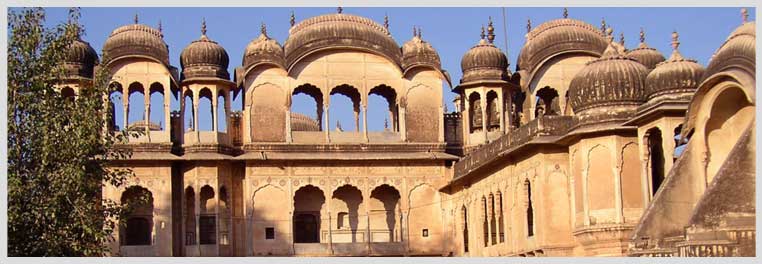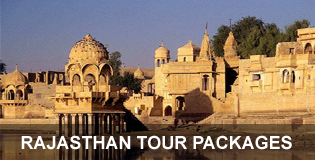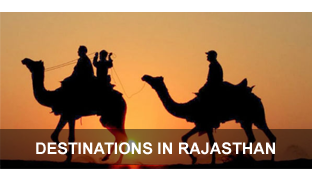Shekhawati Tourism and Travel Guide
"The Open Gallery Of Rajasthan"

Spread over Jhunjhunu, Sikar and Churu districts in north eastern Rajasthan, Shekhawati as a region is known for its beautifully painted havelis, in its nearly 20 odd towns and numerous villages.
In the beginning, 'this semi-arid region had only its blank monochromatic palette to offer. No school of painting thrived till history and circumstances took up this colourless page and made it blossom with art for almost two centuries—from 1750 to 1930. Today, this region is commonly called the 'open-air art gallery of Rajasthan'.
Most of the painted towns and villages are concentrated in the west and the north of Shekhawati and can be reached with eo al ease from Delhi, Jaipur or Bikaner.
Besides the cenotaphs, wells, forts and temples, the majority of frescoes are painted on the havelis. The havelis are mansions of a unique residential architectural style that evolved around courtyards to serve the purposes of family security, privacy for the women, as also protecting the inhabitants from the long, harsh summers. These enormous havelis housed the families of the merchants for a few generations.
The Shekhawati paintings mainly consisted of red, green, yellow and mushroom colours
The earlier frescoes were executed more patiently on wet plaster in the Italian technique of Fresco buono. The technique possibly travelled to Shekhawati from Jaipur, whose contact with the Mughals had exposed them to an art that may well have come to India with European missionaries. While the earlier frescoes were painted in natural pigments, the latter ones usually with chemical dyes, often imported, particularly from Germany. These were painted on dry plaster which did not react with the chemicals.
Since the period in which the frescoes flourished (18301900) was longer than that of their decline and discontinuation (1900-1930), there is a dominance of the earlier style and content. Generally speaking, this was the era of mythological frescoes interspersed with illustrations of local legends, animals, portraits, hunting and wrestling scenes, and glimpses of everyday life.
Gods, heroes, epics and legends were gradually replaced by a broader spectrum influenced by oleographs, lithographs and photographs from England. Traditional Indian miniatures had already crossed with the naturalism of Western paintings to produce curious hybrid results. To emulate the British rulers was to rise in the social hierarchy. Motor cars were more contemporary than elephants, the aesthetic of angels more luring than the local god. Strolling barra sahibs and mem sahibs with dogs on a leash, clumsy trains, bicycles and balloons, aeroplanes, ships, telephones were painted everywhere on the walls. These continue' to fascinate both the foreign and the Indian tourists to Shekhawati.
Sikar District
In feudal times it was the largest contributor to the Jaipur exchequer. Founded in the late 17th century, the town of Sikae has good examples of frescoes in the Gopinath, Raghunath and Madan Mohan temples and the fort. The Jubilee Hall, Madho Niwas Kothi, Biwani Haveli and Sodhani Haveli are also worth visting.
11 km. It is a 10th century Shiva temple situated on Harsh Nath hills. The ruins of the old temple can also be seen there.
29 km from Sikar. According to a belief, the temple of Jeen Mata was built thousand years ago. A fair is held twice a year at the time of Navratra.
This town, founded in the early 19th century by Raja Lachhman Singh of Sikar, is modelled after the planning of Jaipur. Forts and many havelis are worth visiting.
Founded in the mid-1 5th century by Fatéh Khan, a Kayamkhani Nawab, its central location attracted many a merchant to settle, prosper and build some of the finest havelis.
It was founded in the late 18th century by the Poddars who left Churu in discontent. Ceilings of the chhatris are exquisitely painted. The Shani temple of the Saturday god and the temple built to Ganga, are worth seeing.
This village is known for Shri Shyamji temple, built in white marble.
The place is famous for its sacred temple of Sakrai Mãta, built in 7th century. With the hills surrounding it from three sides, the location is an ideal tourist spot.
Jhunjhunu District
The district town of Jhunjhunu, the capital of New Shekhawati, was another stronghold of the Kayamkhahi Nawabs till 1730 when Shardul Singh established Hindu rule and his descendants then ruled this region till India's Independence. The aesthetically painted havel is, easily accessible, are those of Marugh Das Tibriwal, Mehau Dass Modi, Khaitans Further, the Khetri Mahal (Wind Palace) is known for its purity, just as the Bihariji temple deserves admiration for its ornate frescoes. Besides, there are many other places worth visiting in this oldest historical city. Prominent among these are: Badalgarh, Jorawargarh, Mertani Baori, Kamruddin Shah Ki Dargah, Birdi Chand Ka Kuan, Ajit Sagar and Jam Temple.
Founded in the mid-18th century, Mandawa is dominated by a rugged fort-turned-hotel. Of interest are the Chokhani and Ladia havelis as well as the street with the Saraf havelis. The Shiva temple with a rock crystal lingam can also be visited.
This place.has also gained popularity because of its fine havelis. Mukundgarh Fort is now a heritage hotel.
Known for its fort and a palace which has been converted into a hotel. Besides, there are havelis of Goenkas.
Founded in the early 18th century, Nawalgarh has two Oldforts and a palace hotel with gardens and fountains. The Bara Kila has a kiosk where some of the finest frescoes in Shekhawati are painted on the ceiling. Its havelis are as grand as those of Ramgarh, Lachhmangarh and Fatehpur. The prominent havelis here are of Poddars, Chhawachharias, Bhagats, Dangaichs and others. A host of temples with interesting architecture and frescoes are also recommended for a visit.
Founded by the Nagar Pathans in the mid-15th century, it is better known as home of the Rungtas and Piramals.
Located at a crossroad, Chirawa gained popularity as a trading town between Churu and Loharu. There are havelis of Nand Lai Dalmia, Phool Chand Dalmia, Tara Chand Dal,mia and Mangal Chand Dalmia.
A small viIlge that became famous as the home of the Birlas, India's leading industrialists It has a large campus of the Birla Institute of Technology and Science, beautiful Saraswati Temple,. Shiv Ganga, BITS Museum and Panchwati.
The former has a fort built at the end of the 18th century as also painted temples and havelis. The latter has large late 19th century havelis of the Kajaria family.
Lying at the northern extremity of Shekhawati, these towns were founded in the late and mid-18th century respectively. Though off the main road, a trip can be rewarding, particularly since the angular style of the frescoes and their different colour palette are refreshhing. Besides the fort in Alsisar, the Jhunjhunwala havelis and well complex are interesting. In Malsisar, the fort, temples and havelis along the main street are worth exploring.
Founded in the mid-18th century. The chhatris of its Thakurs are splendid. The. Sigtia, Khemka, Tibriwala and Kedia havelis are finely painted.
Founded in the mid-1 8th century, Mahansar can boast of the finest frescoes of Shekhawati. The painters for these, possibly came from Bikaner, since similar work is found in the fort there. It is.worthwhile to visit the Sone-Chandi-ki-Haveli and the Raghunath temple, both built by the Poddars.
Churu Districts
Once on the Shekhawati map, Churu is famous for Kothari haveli (1915), Kanhaya Lal Bugla haveli (1870) with superb life-size paintings of Dhola Maru, Sasi-Punu, etc., the six-storeyed high Surana haveli with more than eleven hundred doors and windows and many other havelis.
Famous for a sacred temple of Hanumanji.
Ratangarh is situated on Agra-Bikaner N.H. 11 and it is 52 km from Churu towards Bikaner. The Raja of Bikaner Ratan Singh named it Ratangarh in 1820 AD by building a fort on the site of a little village. The market of the town is in the shape of a cross giving the impression of a planned town. All the tourist interesting painted havelis are situated around the clocktower at the cross.
46 km from Churu, 150 km from. Bikaner & 210 km from Ganganagar, Sardarshahar is most enchanting town of the desert lovers. The havelis here, besides colourful wall paintings, have some remarkable carved wood work.
36 km from Churu towards Rajgarh. It is a big but an old historical rural village situated in an enchanting topography of the Thar Desert. There are some huge havelis having excellent architectural designs. This village can be visited for enjoying the rural folk life and camel safaris.
The natural habitate of black buck is 100 km away from churu. The endangered species of black buck and some migratory birds can be seen in this wild life sanctuary. Forest guides are there totake visitors around.
| Climate Summer : | Mean Max 40.5°C, Mean Mm 26.8°C |
| Climate Winter : | Mean Max 35.6°C, Mean Mm 10.0°C |
| aRainfalla : | 60 cm |
| Best Season : | September-March |
| Clothing Summer : | Light Tropical |
| Clothing Winter : | Light Woollen |
| Languages : | English, Hindi, Rajasthani |
| Local Transport : | Jeeps, un-metered taxis, auto- rickshaws, cycle-rickshaws and tongas. RSRTC buses cover various towns and villages in the region. |
Travel Information
The towns of Sikar and Jhunjhunu, headquarters of their respective districts, are connected by road as well as by rail with Jaipur, Delhi and Bikaner. Given below are some distances by road:
| Sikar-Delhi : | 299 km via Jhunjhunu |
| Sikar-Jaipur : | 114 km |
| Sikar-Jhunjhunu : | 70 km |
| Jhunjhunu-Delhi : | 231 km via Singhana, Narnaul, Dharuhera |
| Jhunjhunu-Jaipur : | 182 km |
| Jhunjhunu-Bikaner : | 230 km |
| Jhunjhunu-Churu : | 52 km |
| Sikar-Ladnu : | 90 km |
Local shops sell the region's handicrafts which are tie and dye fabrics and furniture. There is a thriving industry in made-as-old-souvenirs.






